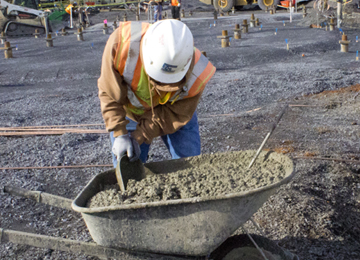Cold weather affects concrete in many ways. Hydration in concrete, the process of gaining strength, is a chemical reaction. When concrete is placed at cold temperatures, hydration can be slowed – even stopped – which impacts finishing and curing times. Permanent damage can also occur if concrete freezes at an early age.
Temperature of Concrete at Placement
The American Concrete Institute (ACI) has developed the following chart, which provides minimum concrete temperatures at time of placement as a function of thickness:
| Section Size, Minimum Dimension | ||||
| Minimum Concrete | 12 inches | 12-36 inches | 36-72 inches | 72 inches |
| Temperature as Placed and Maintained |
55°F | 50°F | 45°F | 40°F |
Carefully monitor the temperature of concrete, formwork, reinforcing steel, subbase, subgrade and any other items associated with placement. Surfaces upon which concrete will be placed should be above 32°F to prevent the concrete from freezing at the interface.
Once normal-set concrete has been placed, it must be maintained at the above temperature and kept moist for at least 72 hours to allow adequate initial curing. Insulating blankets, heated mats, and/or heated enclosures may be necessary. Don’t wait until the last minute to confirm that protective equipment and supplies are on site.
Proper handling of field-cured cylinders is critical during cold weather. When used to confirm suitable field strength for formwork removal, post-tensioning, or steel erection, every reasonable effort must be made to ensure these cylinders receive the same temperature and moisture treatment as the concrete they represent.
Concrete Mix Design During Winter
Modifying concrete mix designs during the winter may be worth considering. Using higher-strength mixes can lead to early strength gain, thereby allowing faster formwork removal. Other suggestions include lower water/cementitious material ratios; adding additional cement; using a non-chloride accelerating admixture; or using a Type III cement (high-early strength).
In the past, calcium chloride was often used as an accelerating admixture, but caution is advised. Chlorides in concrete can increase the possibility of corrosion in the reinforcing steel, which can lead to premature concrete deterioration. Many specifications and code documents limit or completely restrict the use of calcium chloride or admixtures containing chlorides.
Using common mineral admixtures, such as slag or fly ash, should also be approached cautiously during cold weather periods. There are numerous advantages to using mineral admixtures, but they can also retard initial strength gain. This effect tends to be more pronounced in cold weather, and an accelerating admixture may be required if the delayed strength gain impacts finishing or formwork removal.
ACI also recommends using air entrained concrete to minimize damage from freeze-thaw cycles even if the concrete will only be exposed to these cycles during construction.
ECS recommends that you review the guidelines presented in ACI 360R before beginning a cold weather concrete pour. ACI 306R provides additional guidance on the types and duration of protective measures that may be necessary for cold weather concrete placement. An awareness of these factors, coupled with implementing the recommended measures, can help ensure that a good quality concrete product is achieved.

